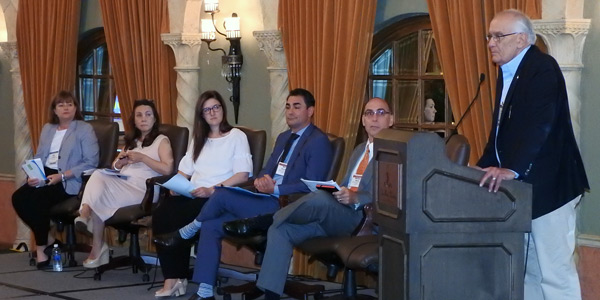By Rory D. Sweeney
HERSHEY, Pa. — Attendees at last week’s Mid-Atlantic Conference of Regulatory Utilities Commissioners conference heard strikingly different prescriptions for how to fix the wholesale energy markets from the CEOs of New Jersey utility Public Service Enterprise Group and independent power producer Dynegy.
In a presentation Monday, PSEG CEO and Chairman Ralph Izzo argued that there’s a “missing money problem” among non-emitting generators. While net-metered residential solar generators are paid a premium of up to $415/MWh for being emissions-free in New Jersey, nuclear units receive no premium for having the same attribute and are paid PJM’s clearing price in their zone.
“We believe that wholesale power markets are experiencing some basic failures,” he said.
PSEG operates the Salem and Hope Creek nuclear plants in New Jersey and is a part owner of the Peach Bottom nuclear plant in Pennsylvania. With low-cost natural gas and subsidized renewables keeping energy prices low, owners of nuclear plants say the facilities are losing money and might be closed unless the states where they’re located cough up zero-emissions premiums for them as well. Such discussions are ongoing in Ohio, Pennsylvania, New Jersey and Connecticut. So far, only Exelon has been successful in securing credits for its units in Illinois and New York.
Izzo also called for changing customers’ bills to ensure that they see the premium they’re paying for solar. Customers of PSEG’s utility arm, Public Service Electric and Gas, have indicated that they’re unwilling to pay more than $5/month for additional renewable energy, but they’re already paying this much and aren’t aware of it because “we don’t tell them,” he said.
“Over the last three years, New Jerseyans have paid over $400 million a year for renewable energy credits, producing less than 2% of the in-state electricity,” he said. “I think that they are deserving of a transparent conversation on matters such as that, and I would be the first to champion the continued payment of that, but they are deserving of knowing about it.”
Dynegy CEO Robert Flexon stressed the favorable economics of his mainly coal- and gas-fired merchant generation fleet. He argued that subsidies for uneconomic units create a “subsidy death spiral” that pushes other units into becoming uneconomic and seeking a subsidy of their own. The result is a dismantling of the market’s basic function to procure energy at the lowest possible cost.
“That’s kinda what we signed up for,” he said.
Flexon argued that “utilities have a different DNA than a merchant generator” in that they are “leaning heavily on their core competency of dealing with the politics — which the [independent power producers] aren’t nearly as good at — and working special deals that upset the flow of the marketplace.”
When utilities are losing money, they go to governments for help, he said.
“You need to help yourself,” he said. “What I think is the biggest threat to reliability is the lack of coordination between the states and PJM, and the states doing things to take the economic generators and push them to the side.”
Dynegy originally sought a bailout for its Illinois coal units while Exelon was seeking the one it ultimately received for its nuclear units. When state support became unlikely, Dynegy pivoted to fight the zero-emissions credits (ZECs), joining a federal lawsuit challenging the state’s action.
Flexon called on regulators to require utilities to “match” any subsidies they receive with equal reductions to their annual dividend distribution. He cited FirstEnergy receiving an annual $250 million distribution modernization rider in Ohio while it distributes $600 million in annual dividends. He said it is unfair for Exelon to receive millions in ZECs over the next 12 years for five of its nuclear plants when it is able to pay $1.1 billion in dividends.
“I would say to the regulators, if you’re going to give them the money, you ought to look to their dividend,” he said. “If you want to shore up the balance sheet, I need the company match.”
In a panel discussion focused on wind energy, panelists also blamed utilities for artificially stalling market forces, but they defended renewable subsidies.
“The electric utility industry is an industry made of large institutions, and these large institutions have billions of dollars invested in assets that they own and operate, so my concern is that [they believe] renewable energy is a threat to the existing [way] of doing business,” said Markian Melnyk, president of Atlantic Wind Connection.
He referenced the assertions by Izzo and Flexon that the renewable sector is subsidized and “undercuts” their business. “My concern is that the federal government would hear that message and then take action to try to limit the advancement of renewable energy,” he said.
Avangrid’s Eric Thumma also defended existing pathways for renewables development, such as state renewable portfolio standards, joking that “it’s hard to take my blankie and my teddy bear away from me.”
State goals have proven effective, he said. “We know the RPS works. We know that it gets projects built.”
Beth Treseder of DONG Energy agreed. “We, too, are primarily looking to the states for leadership,” she said, but added that her company is also investigating how it can “take advantage” of the current federal focus on infrastructure development to improve critical ports and transmission lines.
For states themselves, the push to meet constituent demand for both cheap and environmentally conscious power means focusing on both costs and results.
“We’re balancing the economic and the environmental in our state,” Delaware Public Service Commissioner Kim Drexler said. “In my opinion, we’re really looking at the least expensive way to meet those requirements.”









